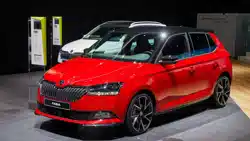Loading ...
Loading ...
Loading ...

Braking and parking
Introduction
The wear and tear on the brake pads is dependent on the operating conditions
and driving style. In difficult conditions (e.g. urban, sporty driving), the condi-
tion of the brakes should be checked between service intervals by a specialist
garage.
Brake response can be slower if the brakes are covered in moisture or, in
winter, have a layer of ice or salt on them. The brakes should be cleaned and
dried by applying the brakes many times over » .
Corrosion on the brake discs and dirt on the brake pads can occur if the vehi-
cle has been parked for a long period and if you do not make much use of the
braking system. The brakes should be cleaned by applying the brakes several
times over » .
Before negotiating a long or steep gradient, reduce speed and shift down a
gear. As a result, the braking effect of the engine will be used, reducing the
load on the brakes. If, nevertheless, there is a need for additional braking, it
should be carried out at intervals.
Emergency braking warning - If it is necessary to brake hard, the system may
cause the brake lights to automatically flash, to alert the traffic behind.
New brake pads must first be““run in”” because these do not initially have the
best possible braking effect. Drive especially carefully for the first 200 km or
so.
If the brake fluid level is too low, it can cause faults in the braking system;
the warning light will light up in the instrument cluster » page 38, Braking
system. If the warning light does not light up, yet the stopping distance is per-
ceived to be longer than before, the driving style should be adapted in view of
the unknown cause of the problem, and braking kept to a minimum - seek the
help of a specialist garage without delay.
The brake booster increases the pressure generated with the brake pedal. The
brake booster only operates when the engine is running.
WARNING
■
Greater physical effort is required for braking when the engine is switch-
ed off – risk of accident.
■
The clutch pedal must be depressed when braking on a vehicle with man-
ual transmission, when the vehicle is in gear and at low revs. Otherwise, the
functionality of the brake system may be impaired – risk of accident!
■
Do not depress the brake pedal, if there is no requirement to slow down.
This causes the brakes to overheat and can also result in a longer braking
distance and excessive wear - The is a risk of an accident!
■
Only brake for the purpose of drying and cleaning the brake discs if the
traffic conditions permit this. Do not place any other road users in jeopardy.
■
Recommendations for new brake pads should be followed.
■
When stopping and parking, the parking brake should always be applied
firmly, otherwise the vehicle could move off - The is a risk of an accident!
■
If a front spoiler, full wheel trim, etc. is mounted retrospectively, it must
be ensured that the air supply to the front wheel brakes is not reduced.
Otherwise, the front brakes could be in danger of overheating – The is a
risk of an accident!
Handbrake
Fig. 210
Handbrake
Read and observe on page 168 first.
The handbrake secures the vehicle against unwanted movement when stop-
ping and parking.
Apply
›
Pull the handbrake lever firmly upwards.
168
Driving
Loading ...
Loading ...
Loading ...
